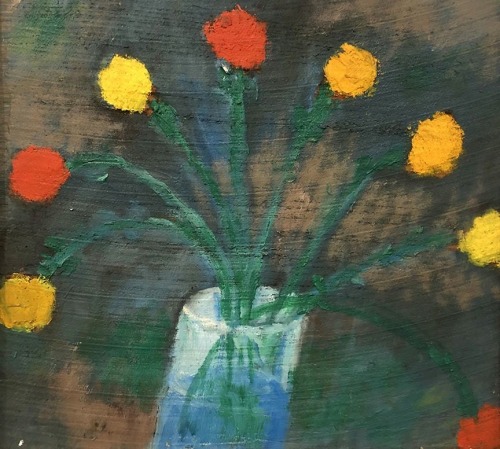
Jan Müller, A Red Flower in the Corner (recto) / Abstract (verso), 1957, Oil on wood shingle, 11 x 12 inches 11 x 12 inches (recto) / 11 x 12 inches (verso). (BP#JM-7476)
The Hudson Review
by Karen Wilkin | Spring 2019
At The Galleries
The rigors of a New York winter were relieved this year by a conspicuously diverse group of exhibitions by a conspicuously wide-ranging group of artists: modern masters, current notables, emerging and emerged talent. Geographically, these shows were also dispersed: Harlem, Chelsea, the Upper and Lower East Side, Brooklyn, and, for the dedicated, Beacon, New York, up the Hudson.
The Northern tradition is continued at Jan Müller: Flowers, at Bookstein Projects on the Upper East Side, a survey of still life paintings from the mid-1950s by this phenomenally gifted, tragically short-lived painter. Müller, born in Germany in 1922, fled Hitler with his family, arriving in 1941 in the United States, where he died at 35 of a heart condition. A student of Hans Hofmann’s, Müller first painted mosaic-like abstractions influenced by his teacher, returning to figuration with the urgent, stylized, expressionist images of biblical and mythological themes for which he is best known—a remarkable trajectory in 1950s New York, when anything other than abstraction was regarded as possible only for amateurs and artists of the past.
Müller’s modest paintings and pastels of casually disposed flowers in cylindrical vases can be read as the link between his abstractions and his fierce narratives. At first, the still lifes seem childlike in their economy, even naïve in their simplicity, yet they become increasingly abstract and intense the longer we spend with them. The patches of clear primary colors that suggest flower heads, along with Müller’s insistent touch, begin to remind us of Hofmann’s vigorous orchestrations of saturated hues and his ferocious stabs of a loaded brush. We begin to see Müller’s still lifes as abstract fabrics of color out of which recognizable, simplified flower images begin to emerge. The flower paintings are at once tender and tough, as if even when he explored ostensibly benign, even banal, subject matter, Müller’s awareness of his own impending mortality animated his paintings. Patches of red, yellow, and blue float against brushy, shifting grounds. Stems fan out in assertive strokes of deep green. These deceptively forthright paintings are the harbingers of his last, haunting narrative paintings.
Müller exhibited regularly during his brief lifetime at the Whitney Museum of American Art, the Jewish Museum, the Museum of Modern Art, and the Venice Biennale. He’s been seen less often, recently. Given the continuing influence of Philip Guston’s late work and the burgeoning interest in pared-down, lushly painted, expressive figuration these days—think Katherine Bradford, Matthew Blackwell, or Dana Schutz, not to mention the late Bob Thompson, Müller’s devoted acolyte —isn’t it time for a full-scale retrospective, a demonstration of the achievement of a prescient, independent-minded artist?
Wilkin, Karen. “At the Galleries,” The Hudson Review, Spring 2019, Vol. LXXII, No. 1.